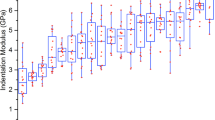Abstract.
Broadband ultrasound attenuation (BUA) of the calcaneus has been found to correlate with bone mineral density (BMD) of the femoral neck. The purpose of this study was to determine if a correlation exists among femoral neck BUA, femoral neck BMD, and incremental indent depth, a qualitative indicator of local mechanical bone strength, in bovine samples, and if this correlation is dependent upon orientation. For 12 of the bovine samples obtained, BUA was measured at the femoral neck and was followed by a BMD determination of the same area. A 19 mm diameter bicortical core containing the center of the area of interest was removed, transversely cut into 7 mm, thick disks, and tested for hardness by indent depth. For these tests, BMD was well correlated with BUA (R2= 0.85, P < 0.001). An inversely proportional relationship with a modest correlation was found between indent depth and BMD (R2= 0.59, P= 0.026), and indent depth and BUA (R2= 0.57, P= 0.031). In a second set of tests involving 15 different bovine samples, a bicortical core was removed from the femoral neck. A trabecular bone cube measuring 1.5 cm on a side was removed from the center of the core. BUA and BMD measurements were made along the anterior–posterior (AP), medial–lateral (ML), and cephalic–caudal (CC) aspects of the cube. The cubes were randomly separated into three groups, cut in half perpendicular to the axis of interest, and tested for hardness by indent depth. In these tests, no significant difference was found in BMD among the three orientations of the cubes scanned (P= 0.77). In contrast, the BUA along the ML orientation of the cube was significantly greater than that along the AP orientation (P < 0.05). No significant difference was found in the incremental indent depth measurements among cube orientations (P= 0.41). In the test involving only trabecular bone, a much higher correlation between BMD and incremental indent depth was found regardless of cube orientation (R2= 0.64, P < 0.001). The data indicate that BUA, but not BMD, is affected by trabecular orientation, and that BMD is negatively correlated with incremental indent depth.
Similar content being viewed by others
Author information
Authors and Affiliations
Additional information
Received: 18 July 1995 / Accepted: 19 July 1996
Rights and permissions
About this article
Cite this article
Duquette, J., Lin, J., Hoffman, A. et al. Correlations Among Bone Mineral Density, Broadband Ultrasound Attenuation, Mechanical Indentation Testing, and Bone Orientation in Bovine Femoral Neck Samples. Calcif Tissue Int 60, 181–186 (1997). https://doi.org/10.1007/s002239900211
Published:
Issue Date:
DOI: https://doi.org/10.1007/s002239900211




